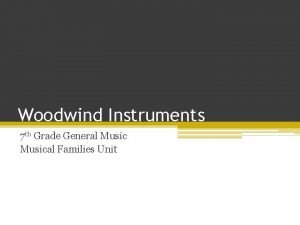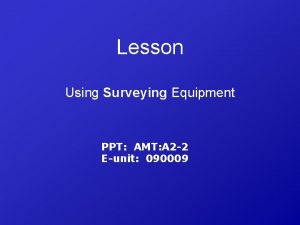The Instruments and Their Families There are four















- Slides: 15

The Instruments and Their Families

There are four major families in the orchestra. The Strings, Woodwinds, Brass, and Percussion make up the orchestra. • Ask yourself how each instrument sounds: Was it high or low? Have you heard this instrument before? How is it played? • How does the instrument look: What is it made out of? How is it shaped? How many strings does it have? • Families as highlighted: • Strings • Woodwinds • Brass • Percussion

Strings: The string section is made up of violins, violas, cellos, basses, harps, and often a piano. Please try to compare and contrast each instrument in this family as you learn. • Violin: The smallest string instrument in the orchestra and the most abundant. It is rested on the musician’s shoulder when played and has four strings. • Viola: The viola is easily confused with the violin because they look very similar, but the viola is larger and has a lower sound. The viola is played in a similar position on the shoulder to the violin. • Cello: Much larger than the viola, the cello is rested on the ground by its endpin when played. • Do you think the cello sounds higher or lower than the violin and viola? • Answer: • lower

Strings: • Double Bass: The double bass is much larger than many of you! It is so large that it is played in a standing position. • Of the four string instruments we have learned so far which instrument sounds the highest and which sounds the lowest? • Piano: Many of your may wonder why the piano is in the strings family! When you press down a key, a felt hammer strikes one or two of the almost 230 strings inside of the piano. This is what produces a sound. The piano has the widest range of sound of all instruments, which means that it can play very high and very low. The picture to the right features a piano player – also called a pianist. Pianists play with the orchestra sometimes, but also as soloists. A soloist is a performer that plays a part or whole piece of music alone. • Answer: • Highest: Violin, Lowest: Double Bass

Woodwinds: The woodwind section of the orchestra is made up of flutes, clarinets, oboes, and bassoons. Please try to compare and contrast each instrument in this family as you learn. • Flute: The flute is one of the highest instruments in the orchestra. To make a sound, players blow air across the mouthpiece. • Have you seen a flute anywhere else in this lesson? • Clarinet: The clarinet is a single reed instrument. The reed produces a sound when the player blows on the mouthpiece a certain way because it vibrates. Like other woodwinds, the clarinet has many different keys. Each fingering, or set of keys pushed down together, produces a different note. • Oboe: The oboe is a double reed woodwind. Sound is produced when a player blows into the reed and it vibrates. The oboe is the higher of two double reed woodwinds we will talk about today.

Woodwinds: • Bassoon: The bassoon is the other instrument in the woodwind family that uses a double reed to play. The bassoon is much larger and makes a lower sound than the oboe. Like other woodwinds, the bassoon has many keys. • What woodwind instrument that we have learned about today is the lowest sounding? • Answers: • Yes: She was playing flute with the piano soloist • The bassoon

Brass: The brass section in the orchestra is made up of French horns, trumpets, trombones, and tubas. • French Horn: The French horn is played by buzzing your lips on the mouthpiece while blowing air into the horn. It has a very round sound. A round sound means a very balanced, pleasing sound. Players change notes with valves. • Trumpet: The trumpet is played in a similar way to the French horn. The trumpet has a very bright sound. Bright sounds are made by higher, lighter sounding instruments. People often connect this sound with happiness or airyness. Players change notes with valves. • Trombone: The trombone is different from most instruments, because it uses a slide to change notes rather than valves. The trombone can play lower than trumpets and French horns. Sound is produced in a very similar way to the other brass instruments. • Tuba: The tuba is the biggest and lowest brass instrument. It is so big that players must hold it in their lap to play. Sound is produced in a very similar way to the other brass instruments.

Percussion: The percussion instruments we’ll learn about today are the timpani, xylophone, snare, and chimes. Please try to compare and contrast each instrument in this family as you learn. • Timpani: Pitched drums that come in sets of three or four and that vary in note name and size. They are played when struck on the drum head by a timpani mallet. The timpani is a very important part of the orchestra. They have a very round sound. • Do you remember what a round sound means? • Xylophone: The xylophone is made of bars that all produce different notes when struck. They have a very bright sound. • Do you remember what a bright sound means? • Snare: Unlike the timpani or xylophone, the snare does not play different notes. It is played by being struck by a wooden drumstick, and helps the orchestra in keeping time. • Chimes: Chimes are played by hitting the tops of the tubes with a rubber hammer. Each tube produces a different note.

It’s never too early to start playing an instrument. It’s a fun and rewarding experience! Who do you know that plays an instrument?

Now that you know what you will be listening to, let’s learn how to listen!

How to listen to an orchestra performance

What to listen for: • Why do you think the orchestra sits in this arrangement? • It’s all about volume! • The softer instrumental families sit in the front by the conductor. • What order, softest to loudest, would you place the families? *remember that the four families are percussion, woodwinds, brass, and strings* • Answer: Strings, Woodwinds, Brass, and Percussion

What to Listen for: • Why would the violins sit before the trombones? • Answer: Because the violins play much softer than the trombones. The violins are closer to the audience, and the audience can hear them better.

What to listen for: • Please review the questions below and keep them on your mind as you listen to a few minutes of this link: • https: //www. youtube. com/watch? v=KU 1 X 3 W ut-k 0 • Can you hear the different families trade off in the music, but play as an orchestra in the whole? • What do you imagine this music to be about? • Where do you imagine that this music takes place? • Now keep these questions on your mind as you listen. • Composer/Title: George Gershwin, An American in Paris

Concert Etiquette: • Please play this link to the concert etiquette rap: https: //youtu. be/ykk 5 TF-p. Kw 4 It’s okay to laugh at this video, but after watching it you’ll know what not to laugh at in a concert setting! • Review: Please be seated on time. Turn off electronic devices. Do not talk or make noise after the concert begins. Applaud when the concertmaster and conductor enter. Wait for the entire piece to be completed before you applaud (you will know when to applaud when the conductor lowers his arms and turns around/ steps off the podium). • It is fantastic to show your appreciation for the performance with your applause, but please keep it light, not overly enthusiastic. • Enter and exit between selections. If possible, wait until the audience is applauding before moving. • • •
 Four families of musical instruments
Four families of musical instruments Antigentest åre
Antigentest åre Reed instrument
Reed instrument Little families
Little families Characteristics of ttl logic family
Characteristics of ttl logic family Musical families instruments
Musical families instruments 4 instrument families
4 instrument families An passive instrument is
An passive instrument is Pressure measuring devices
Pressure measuring devices Four skills families need to stay healthy
Four skills families need to stay healthy Four instrument families
Four instrument families Instrument families of the orchestra
Instrument families of the orchestra Total station ppt
Total station ppt Brass family
Brass family On base curls
On base curls 4 pin curl bases and their uses
4 pin curl bases and their uses



























